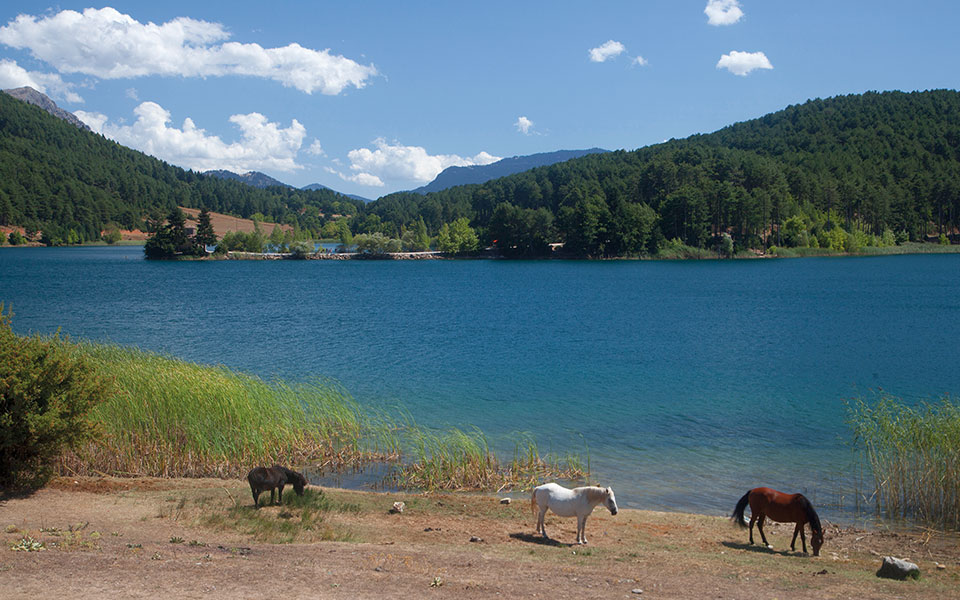The old-school campervan has settled in the dense shade of a tree and does not look set to move for any reason. Its owners, a family from Patras, appear to have found their own slice of heaven on earth. Flippers, buckets and plastic rakes are spread out on the sand, fishing rods and hammocks are close by – it looks like they are here to spend the whole summer. “This is what we are planning,” they confirm enthusiastically, and go on to describe the calm of the mountainous areas, swimming in the lake, the freedom they experience. “What about mosquitoes,” I ask. They look at me disdainfully, as if I am concerning myself with incidental details.
I don’t share their desire to dive into the greenish lake water, but the rest of the “package” is truly appealing. A little further another group are SUPing, others cycling or hoseriding. All are perfectly reflected in the still waters of Lake Doxa. The president of Ancient Feneos, the local community, Apostolos Papoutsis, once told me the most magical image of the lake is in winter, when everything is covered in snow and there are plenty of visitors thanks to the nearby Trikala Corinthias and the Ziria Ski Centre. It seems however that Doxa is equally interesting – and popular – in spring and summer.
It is just 170 km from Athens, which is two to two-and-a-half hours’ journey, easily undertaken all seasons of the year, even for a day trip. Picture the scenery: calm waters, dense pine forest and high mountains all around – the slopes of Oligyrtos, Chelmos, and Ziria. Birds tweet, frogs hop into the shallows, fish disturb the lake’s surface now and again.
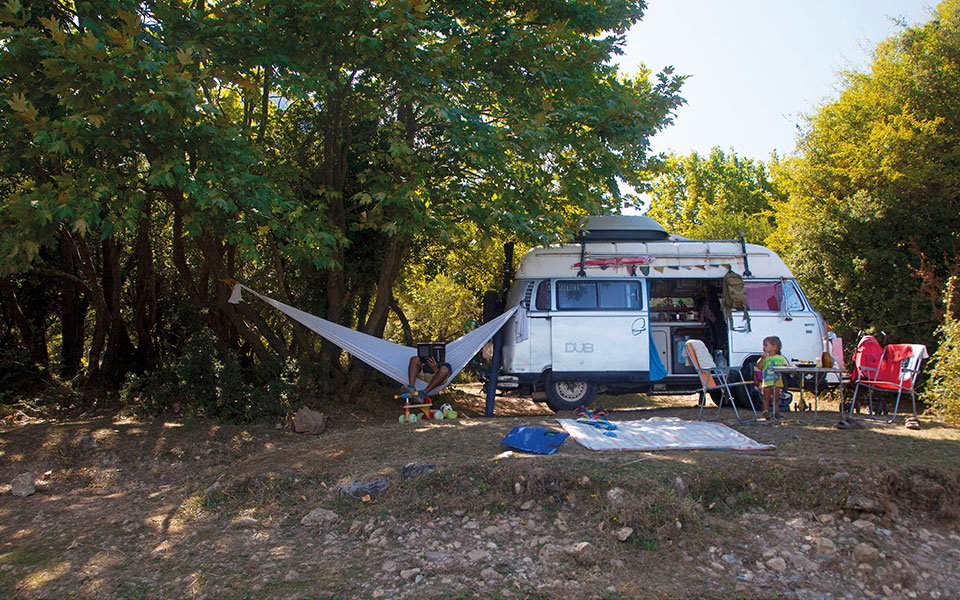
© Olga Charami
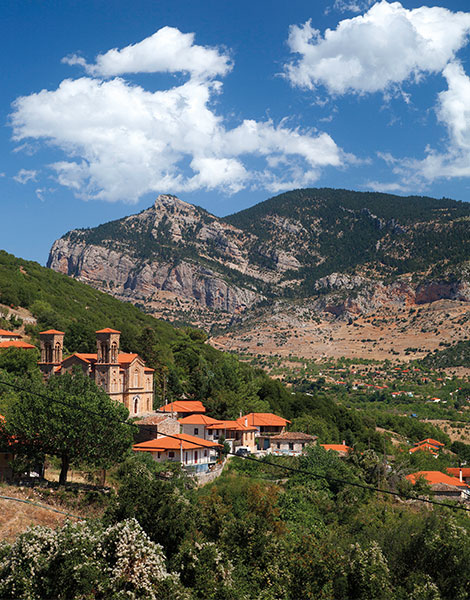
© Olga Charami
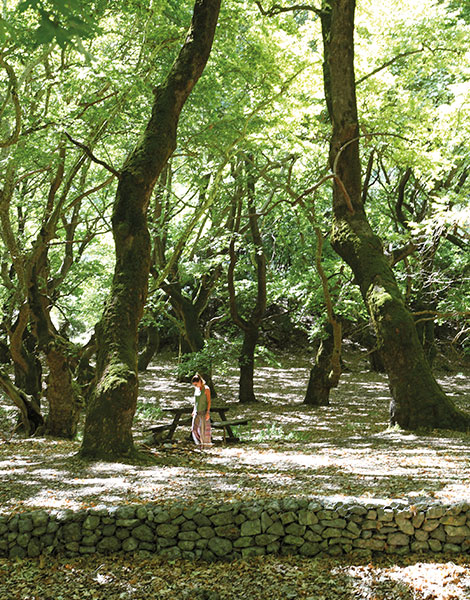
© Olga Charami
Doxa is a man-made lake that was created 26 years ago with the building of a dam. It is so small that you can walk its 5km circumference in less than an hour. In the middle, on a small spit of land, is the church of St Fanourios and the ruins of Palaiomonastiro. The famous monastery of St George the Murderer, dating to the 14th century, is a little higher up. There are three good reasons to visit it: the view of the lake, the rose petal spoon sweet made the monks, and the impressive altarpiece dating to 1762. The third pilgrimage of the area is the Panaghia (Holy Virgin) of the Rock at Tarsos, a cave-like church hewn into the imposing rocks, reminiscent of Meteora. It is accessible by stone paths.
If you time your visit carefully you could also visit the archaeological site of Ancient Feneos, however not many building survive of the ancient site.
You can also visit the village of Goura, the most picturesque in the vicinity of the lakes, and enjoy a coffee or a tsipouro in one of the cafes on pretty square, against the backdrop of the mansions and the church of the Taxiarchs. For something more action packed, you can follow the dirt track from Goura to Ziria and the plateau of Skafidia with its wild horses. There are tame horses for riding by the lake and the forest, which can be arranged by contacting the Patsios family (tel. (+30) 698.861.9915).
Alternatively, you can spend the day on a canoe or a paddleboat on the lake, or take a mountain bike or an electric bike into the surrounding forest, enjoy a hike or an excursion in a 4×4, or take a picnic. All of these activities can be booked at the Efcharis Filoxenon guest house (Tel. (+30) 694.476.8115) in Feneos village. We drove the 20 km dirt track to Planitero Achaias, and a whole new scene. From the conifer forest and the calm of the lake, we found ourselves among the plane trees at the source of the Aroanios river.

© Olga Charami
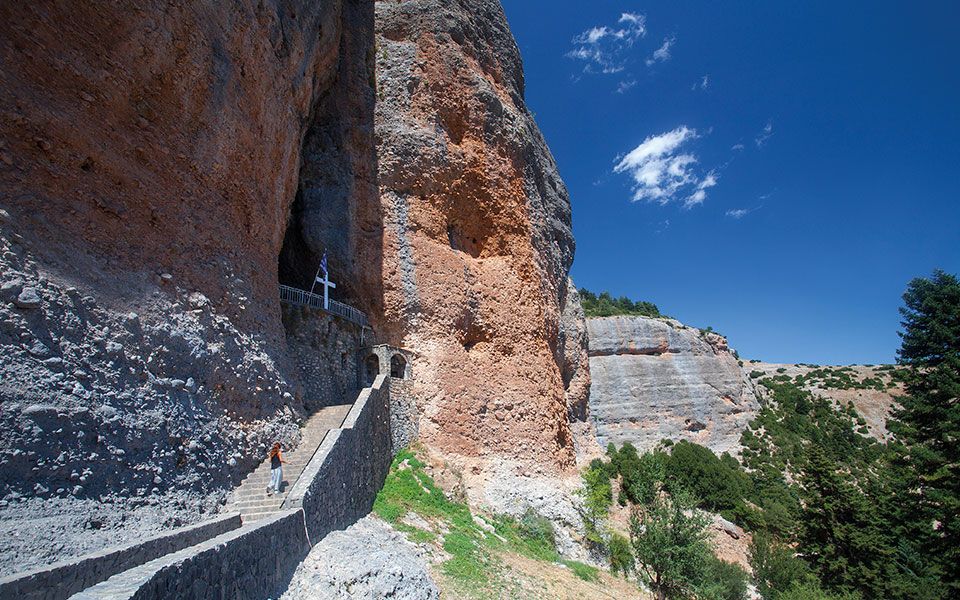
© Olga Charami
Beans and birds
Even if you don’t undertake any activities, you can just continue the enjoyable road trip upwards towards Ziria. In the villages along the way you can shop for the famous pulses of the region (the PDO “vanilla” beans of Feneos, PDO fava and lentils) that are grown in the Feneos valley, at an altitude of 700-800 meters. You can dine at the Trikrina taverna (Tel. (+30) 274.704.1033), which will more than satisfy you. You will have views all along the river valley as you climb up the mountain, until you cross the saddle, where you will look down on lake Stymphalia.
The lake is hardly visible among the dense reeds which shelter dozens of bird species which either nest here or stop on their migration routes. According to Greek legend, this was the home of the monstrous man-eating Stymphalian birds, which Hercules was tasked with driving away in his sixth labor.

© Olga Charami
Along the southern side of Stymphalia, starting at the village of Lafka, you can enjoy tranquility. Many sections of the shore are visible, there is a picnic stand, and you can hear and see birds. On the northern side is mostly farmland. You will come across farmers working the land, shepherds with their flocks and tiny villages. On this side there are also several sites to visit. There is the ruined Zorakas monastery, a 13th century abbey briefly occupied by the Cistercian monks, as well as the remains of Ancient Stymphalos, which mostly date to the Hellenistic period.
The most interesting site, though, is the Environment Museum of Stymphalia which is funded by the Piraeus Bank Group Cultural Foundation. (Tel. (+30) 274.702.2296, open daily except Tuesdays, 10:00-18:00). Here you will learn that the area has been inhabited since the Middle Paleolithic period, and you can see objects testifying to human activities on the lake’s shores through time.
The lake is the southernmost mountain wetland in the Balkans and is a protected habitat in the Natura 2000 network. You can enjoy a view of the lake through the panoramic window and bird-watch using the special equipment, while children will love the glassed-in section of the lakebed, where they can ride a boat among real fish and plants. You can then take the road down to Kiato for your return. Time and weather permitting, a dip at one of the beaches of the Corinthian Gulf is highly recommended.

